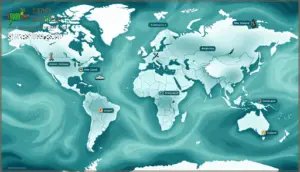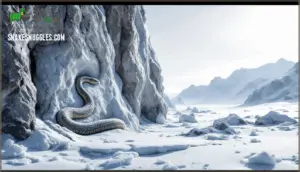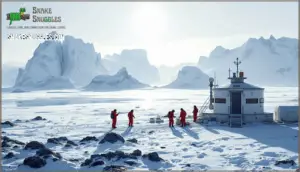This site is supported by our readers. We may earn a commission, at no cost to you, if you purchase through links.

While snakes have conquered nearly every other habitat on the planet, from scorching deserts to tropical rainforests, Antarctica’s extreme cold and isolation have created an impenetrable fortress. The factors that make snake habitat in Antarctica impossible reveal fundamental truths about reptile biology and the limits of adaptation.
Understanding why snakes can’t survive here also sheds light on other snake-free regions around the world and what it takes to protect these unique ecosystems.
Table Of Contents
- Key Takeaways
- Why Antarctica Has No Snakes
- Snake-Free Regions Around The World
- Key Factors Limiting Snake Habitats
- How Snakes Adapt to Other Environments
- Protecting Snake-Free Ecosystems
- Frequently Asked Questions (FAQs)
- Is there a snake that lives in Antarctica?
- Do any reptiles live in Antarctica?
- Do any snakes live in the Arctic?
- What animal is only found in Antarctica?
- Are there any snakes found in the surrounding islands of Antarctica?
- How do the extreme temperatures in Antarctica affect snake physiology?
- Are there any plans to introduce snakes to Antarctica for research purposes?
- How does the lack of snakes impact the overall ecosystem of Antarctica?
- Can snakes survive in Antarcticas surrounding oceans?
- What role do Antarctic seals play without snakes?
- Conclusion
Key Takeaways
- Antarctica’s extreme cold, perpetual ice, and geographic isolation create insurmountable barriers for cold-blooded snakes, which require external warmth to regulate metabolism, digest food, and survive—conditions this frozen continent has never provided.
- Several other regions remain snake-free through different mechanisms: Ireland’s post-glacial isolation prevented snake migration, New Zealand maintains strict biosecurity laws, and Greenland combines Arctic cold with protective regulations to preserve its vulnerable ecosystem.
- Cold-blooded reptiles depend on warm seasons, consistent sunlight, and accessible prey to thrive, which explains why snake distribution stops at extreme latitudes where thermal energy becomes too scarce to sustain basic biological functions.
- Protecting snake-free ecosystems requires coordinated global efforts including the Antarctic Treaty System, biosecurity measures at borders, and public awareness campaigns, since introducing non-native snakes to these isolated environments would trigger irreversible ecological collapse.
Why Antarctica Has No Snakes
Antarctica stands as one of Earth’s most extreme environments, and you won’t find a single snake slithering across its icy landscape.
Understanding why this frozen continent remains snake-free requires looking at several interconnected factors. Let’s explore the main reasons that make Antarctica inhospitable to these cold-blooded reptiles.
Extreme Climate and Low Temperatures
When temperatures plummet to minus 130 degrees Fahrenheit, Antarctica becomes a frozen wasteland where cold-blooded reptiles simply can’t generate the body heat they need to survive. Snakes rely on external warmth to regulate their metabolic rates, but Antarctica’s freezing temperatures make cold adaptation impossible.
Without consistent sunlight or warm seasons, these cold-blooded animals can’t maintain basic survival strategies, leaving this cold climate as one of Earth’s most extreme snake-free zones where reptile distribution stops completely.
Lack of Prey and Vegetation
Even in warmer conditions, snakes wouldn’t find much to eat on Antarctica’s barren ice sheets, where the food web lacks the small mammals, birds, and insects that fuel reptile diets elsewhere. This vegetation scarcity creates a broken ecosystem balance that can’t support predators like snakes:
- Limited food sources mean no rodents or ground-nesting birds
- Prey availability drops to nearly zero on frozen terrain
- The food web impact extends from absent plants to missing herbivores
- Environmental factors prevent the ecological balance snakes need to hunt and thrive in cold climates
Geographic Isolation and Natural Barriers
Antarctica sits more than 600 miles from the nearest landmass, surrounded by some of Earth’s roughest oceans that act like a frozen moat keeping snakes—and most other reptiles—from ever reaching its shores. This geographic separation demonstrates Island Biogeography principles, where natural barriers prevent species dispersal across vast distances.
| Barrier Type | Effect on Snakes | Related Concept |
|---|---|---|
| Drake Passage | Blocks migration routes | Geographic isolation |
| Ocean currents | Prevents rafting dispersal | Species dispersal limits |
| Ice shelves | Creates physical barriers | Continental drift effects |
| Distance | Limits colonization | Evolutionary bottleneck |
You won’t find endemic species of snakes here because the absence of snakes stems from Antarctica’s isolation—no Continental Drift brought reptiles south before the freeze.
Evolutionary History of Antarctic Wildlife
Long before Antarctica became a frozen wasteland, fossil discoveries reveal it hosted lush Nothofagus forests, dinosaurs, and mammals with Gondwanan connections to South America and Australia. Climate impacts from Eocene cooling 34 million years ago drove mass extinctions, leaving only relict species like endemic mosses and microscopic soil fauna. The Antarctic fossil collection includes diverse specimens from this period.
Modern biodiversity remains sparse—geographic isolation and evolutionary history explain the absence of snakes in cold climates where survival became impossible.
Snake-Free Regions Around The World
Antarctica isn’t the only place where you won’t find snakes slithering around. Several other regions across the globe share this unusual characteristic, each with its own story of why snakes never made it there or couldn’t survive.
Let’s look at these snake-free zones and what makes them so inhospitable to these cold-blooded reptiles.
Ireland and Its Fossil Records
Ireland’s fossil records tell a fascinating story—snakes never made it to the Emerald Isle, not even in ancient times. After the last Ice Age, rising seas isolated Ireland before reptiles could migrate there. The glacial impact and postglacial colonization window was too brief.
Unlike Antarctica, where climate alone prevents snakes, Ireland’s reptile absence stems from geographical isolation and historical timing, not just cold temperatures.
New Zealand’s Strict Biosecurity Laws
New Zealand takes biosecurity seriously—so seriously that bringing a snake into the country could land you in legal trouble or hit your wallet hard with fines. These stringent laws protect snake-free zones through:
- Border control that screens all imports and travelers
- Public awareness campaigns about invasive species risks
- Economic impact assessments preventing ecosystem disruption
Like Antarctica’s climate barrier, New Zealand uses geographical isolation plus strict biosecurity effectiveness to maintain its unique, snake-free environment.
Greenland’s Regulations and Ecosystem
Greenland’s frigid landscape doesn’t just keep snakes away naturally—the government backs it up with regulations that treat exotic pets like potential ecosystem threats. You need police permission to own even a single snake, protecting Greenland’s unique wildlife from invasive species that could disrupt this vulnerable Arctic ecosystem.
| Factor | Impact on Snake Absence |
|---|---|
| Climate Impact | Cold climates prevent snake survival year-round |
| Conservation Policies | Strict pet ownership laws protect ecosystem vulnerability |
| Ecosystem Vulnerability | Limited biodiversity makes snake-free locations fragile |
Like Antarctica, Greenland demonstrates how natural barriers and human oversight work together.
Iceland’s Unique Environment and “Sand Snakes”
Iceland’s weather isn’t just cold—it’s a relentless combination of harsh winds, minimal sunshine, and freezing temperatures that makes survival impossible for cold-blooded reptiles like snakes. Yet Iceland has its own "sand snakes"—a phenomenon where volcanic activity creates flowing sand formations that mimic serpent movement across the landscape.
This snake-free location showcases how geographic factors and environmental conditions shape unique wildlife:
- Geothermal impact from volcanic activity creates unusual geological features
- Cold climates prevent snakes from regulating body temperature effectively
- Ecosystem balance remains undisturbed without reptilian predators
- Sand snake origins stem purely from wind patterns, not actual serpents
Comparison With Other Snake-Free Areas
What connects these snake-free zones beyond Antarctica? You’ll find common threads: climate, natural barriers, and strict biosecurity measures. While Cape Verde and Pacific islands like the Cook Islands rely on evolutionary factors and thousands of kilometers of ocean isolation, Ireland and Greenland share cold climates that prevent snake survival. New Zealand stands apart with active biosecurity enforcement under its 1993 Act, while Iceland’s volcanic ecosystem differs entirely from Ireland’s temperate one. Ireland’s snake-free status is further supported by its post-glacial isolation, which limited the time for snake colonization.
| Region | Primary Factor | Key Characteristic |
|---|---|---|
| Cape Verde | Geographic isolation | 4,033 km² with zero snake records |
| Cook Islands | Ocean barriers | Only eel species present |
| Ireland | Post-glacial isolation | 84,421 km² snake-free for 10,000 years |
| Greenland | Arctic climate | Temperatures below 0°C annually |
| New Zealand | Biosecurity laws | 100% removal record through 2024 |
These isolated ecosystems demonstrate how geographic factors influencing snake presence create distinct patterns—some rely on nature’s defenses, others on human intervention.
Key Factors Limiting Snake Habitats
Snakes can’t survive just anywhere—they need specific conditions to thrive. As cold-blooded reptiles, they face real challenges when environments don’t meet their basic needs for warmth, food, and accessibility.
Let’s look at three key factors that determine where snakes can and can’t live.
Temperature Regulation in Cold-Blooded Animals
Snakes are ectotherms, meaning they can’t generate their own body heat. You’ll find they depend entirely on environmental warmth to raise their metabolic rate and stay active.
Without external heat sources, reptiles like snakes can’t digest food, move efficiently, or survive. Their behavioral adaptations, such as basking in sunlight, only work where thermal tolerance allows. Cold climates make temperature regulation impossible for these cold-blooded animals.
Importance of Warm Seasons and Sunlight
You won’t see snakes thriving anywhere unless warm seasons and consistent sunlight provide the thermal energy they need to fuel basic survival functions. Sunlight exposure directly controls their metabolic rates, dictating when they can hunt, digest, and reproduce. Without adequate seasonal activity windows, survival thresholds become impossible to maintain.
- Breeding cycles depend on consistent warmth—no sun means no offspring
- Metabolic rates plummet in cold climates, halting digestion completely
- Environmental conditions in snake habitats must offer reliable heat sources
- Climate shapes snake distribution worldwide, excluding frigid regions entirely
- Impact of climate on snake distribution explains why you’ll never find them in Antarctica
That’s why cold climates and snakes simply don’t mix.
Geographical Isolation Preventing Migration
Even with perfect temperatures, oceans and vast ice sheets lock certain places away from the serpents that might otherwise slither their way in.
Island Biogeography shows how geographical separation, like Antarctica’s isolation, blocks dispersal mechanisms. Continental Drift and evolutionary bottlenecks further limit habitat accessibility, shaping snake-free zones and restricting snake distribution.
Isolation and snake migration go hand in hand.
How Snakes Adapt to Other Environments
While Antarctica remains too harsh for any snake species, these impressive reptiles have mastered survival in environments that would challenge most animals. You’ll find snakes thriving everywhere, from scorching deserts to temperate forests, each species equipped with adaptations shaped by millions of years of evolution.
Let’s explore how these cold-blooded creatures push their biological limits across the planet’s diverse landscapes.
Snake Species in Arctic and Temperate Zones
While no snakes can survive Antarctica’s frozen extremes, a few hardy species have adapted to life near the Arctic Circle and across temperate regions where winters still bite hard. You’ll find the common European adder thriving farther north than any other snake, pushing into Scandinavia’s Arctic zones.
These cold-climate snakes master snake hibernation, retreating underground for months when temperatures plummet. Temperate snake diets focus on seasonal prey abundance, with species timing reproduction around brief warm windows in their geographic range.
Adaptations for Survival in Harsh Climates
Cold-blooded animals like snakes can’t generate their own heat, so they rely on brumation strategies and hibernacula selection to survive harsh climate conditions. During hibernation, you’ll see fascinating adaptations unfold:
- Freezing tolerance in garter snakes allows up to 40% body water freezing for 10 hours
- Cryoprotectant production of taurine and glycerol prevents deadly ice crystal formation
- Thermal gradients along the body keep essential organs warmer than extremities
- Brumation strategies slow heart rates, enabling months without food
- Hibernacula selection provides insulation and predator protection
These environmental conditions shape snake habitats worldwide, showcasing the adaptability of wildlife.
Habitats in Deserts, Forests, and Grasslands
From scorching sand dunes to dense forest floors, snakes have mastered the art of thriving in nearly every terrestrial environment on Earth. You’ll find Desert Snake Habitats supporting sidewinders, Forest Snake Ecosystems sheltering tree pythons, and Grassland Snake Species like rat snakes controlling rodent populations.
| Environment | Snake Species | Key Adaptations |
|---|---|---|
| Deserts | Sidewinders, rattlesnakes | Heat tolerance, nocturnal hunting |
| Forests | Pythons, vine snakes | Climbing ability, camouflage |
| Grasslands | Rat snakes, garter snakes | Speed, prey tracking |
| Tropical | Boas, cobras | Moisture adaptation, diverse prey |
Snake prey availability and environmental conditions shape these habitats, making Habitat Conservation Efforts essential for protecting snake habitats worldwide.
Impact of Introducing Snakes to New Ecosystems
When non-native serpents slip into vulnerable ecosystems, the ecological consequences can ripple through food webs with devastating speed. These invasive predators overwhelm prey populations, trigger biodiversity loss, and create ecological imbalance that conservationists struggle to reverse. Consider the fragility of ecosystems when snakes invade snake-free zones:
- Native birds vanish as non-native species hunt unprotected nests
- Small mammals face extinction without evolutionary defenses
- Ecosystem disruption cascades through plant pollination cycles
- Conservation efforts require decades to restore balance
- Imbalance effects threaten entire food chains permanently
Snake control programs demonstrate how protecting vulnerable habitats preserves nature’s delicate architecture.
Protecting Snake-Free Ecosystems
Snake-free regions like Antarctica aren’t just frozen curiosities—they’re living laboratories that show us how isolation shapes life on Earth.
These ecosystems are surprisingly fragile, and keeping them that way requires vigilance from scientists, governments, and conservationists worldwide.
Let’s look at what it takes to protect these unique environments from unwanted visitors.
Scientific Research and Conservation in Antarctica
Antarctica operates as one of Earth’s most carefully monitored snake-free zones, with over 80 research stations from approximately 30 nations tracking everything from climate shifts to invasive species.
The Antarctic Treaty System, signed by 56 parties, enforces strict conservation policies that protect these unique ecosystems from contamination.
Scientists document roughly 1,204 non-native species across 36 localities, using biosurveillance standards to prevent any organisms—including snakes—from disrupting this frozen wilderness through coordinated conservation efforts and snake control protocols.
Fragility of Isolated Environments
Isolated ecosystems act like islands adrift in time—cut off from the rest of the world, they become fragile laboratories where one wrong introduction can unravel millions of years of evolution. Antarctic snake-free zones illustrate this ecosystem sensitivity perfectly. Endemic vulnerability increases when unique wildlife lacks defenses against invasive threats:
- Native species evolved without predators like snakes
- Food webs collapse rapidly from new arrivals
- Climate impact accelerates habitat stress
- Limited genetic diversity reduces adaptation capacity
- Recovery takes centuries in extreme cold
The fragility of ecosystems demands a conservation imperative to protect Antarctica’s irreplaceable biodiversity.
Global Efforts to Prevent Invasive Species
Countries around the world have built invisible borders through laws and inspections—barriers that don’t need walls or fences to keep invasive species from crossing into vulnerable ecosystems. Biosecurity measures include strict border control at airports and ports, where inspectors screen for non-native species that could trigger ecological imbalance.
International treaties coordinate eradication programs, while public awareness campaigns educate travelers about protecting snake-free zones. These conservation laws shield fragile ecosystems from threats that wings, fins, or scales might carry across continents.
The Importance of Preserving Unique Wildlife
Every ecosystem tells a story written in the DNA of its inhabitants—and when you erase one character from that narrative, the entire plot can unravel. Biodiversity loss triggers cascading ecological imbalance that conservation laws alone can’t fix.
Your conservation strategies today determine whether future generations inherit thriving snake-free zones or sterile landscapes.
Ethical considerations demand we protect these unique ecosystems without snakes from non-native species, preserving ecosystem balance for tomorrow’s discoveries.
Frequently Asked Questions (FAQs)
Is there a snake that lives in Antarctica?
No snake species call Antarctica home. The continent’s frozen landscape makes survival impossible for these cold-blooded animals, which need external warmth to regulate body temperature—a requirement that Antarctic conditions simply can’t meet.
Do any reptiles live in Antarctica?
No reptiles currently live in Antarctica. Reptiles vs Antarctica comes down to cold-blooded animals needing external heat sources to regulate body temperature—environmental conditions and snake habitats require warmth that this reptile-free environment simply can’t provide.
Do any snakes live in the Arctic?
No snakes inhabit the Arctic. While some species tolerate cool climates, Arctic ecosystems remain snake-free locations.
Environmental conditions—extreme cold, limited prey, short summers—create barriers that exceed even the most cold-tolerant snake’s survival threshold, preventing any snake migration into these harsh Arctic snake habitats.
What animal is only found in Antarctica?
The Weddell seal stands out as one of Antarctica’s truly endemic species. You’ll find these marine mammals thriving in the icy waters and coastal regions, perfectly adapted to the extreme cold through thick blubber and specialized diving abilities.
Are there any snakes found in the surrounding islands of Antarctica?
You’d think subantarctic islands might harbor snakes, but they don’t. These islands have milder temperatures and more water than mainland Antarctica, yet biogeographic snake barriers and extreme isolation keep all snake species out completely.
How do the extreme temperatures in Antarctica affect snake physiology?
Extreme cold halts the metabolic processes cold-blooded animals need for survival. Snakes can’t generate body heat, so freezing temperatures shut down digestion, movement, and reproduction.
Without warm seasons or sunlight to regulate their body temperature, Antarctic snake physiology simply couldn’t function.
Are there any plans to introduce snakes to Antarctica for research purposes?
Consider this: bringing snakes to Antarctica would be like opening Pandora’s box. No research justification outweighs the ethical considerations and potential ecological impact on this fragile ecosystem.
Introducing snakes to Antarctica would unleash irreversible ecological harm that no scientific justification could ever outweigh
Containment strategies can’t guarantee preventing ecological imbalance caused by non-native species.
How does the lack of snakes impact the overall ecosystem of Antarctica?
You might think predator absence would disrupt everything, but Antarctica’s ecosystem stability doesn’t depend on snakes.
The food web evolved without cold-blooded animals needing warm seasons for survival, creating unique adaptations shaped by geography and ecology.
Can snakes survive in Antarcticas surrounding oceans?
No sea snakes inhabit Antarctic waters. These cold-blooded animals can’t regulate body temperature in frigid oceanic conditions below freezing.
Even marine snake species adapted to temperate zones lack the evolutionary pressures needed for survival here.
What role do Antarctic seals play without snakes?
Antarctic seals thrive as mid-level predators in a snake-free ecosystem, maintaining seal population control through natural predator-prey dynamics.
Their diet variation maintains Antarctic food web balance, consuming fish and krill without competition from cold-blooded animals like snakes in these snake-free zones.
Conclusion
Antarctica’s frozen fortress proves that even evolution has its limits—no amount of time could transform a snake into a creature that thrives at negative fifty degrees. The absence of snake habitat in Antarctica isn’t just about cold; it’s a reminder that some barriers can’t be crossed.
As you explore other snake-free regions like Iceland and New Zealand, you’ll notice a pattern: isolation protects ecosystems. Preserving these unique environments means respecting nature’s boundaries and keeping invasive species where they belong.
- https://www.bas.ac.uk/data/our-data/collections/geological-collections/fossils-from-the-antarctic/
- https://www.antarctica.gov.au/about-antarctica/geography-and-geology/geology/antarctic-prehistory/
- https://peachv.org/images/GeoRest/AntarFossilRecordAntarcticMammalGelfo.pdf
- https://www.pnas.org/doi/10.1073/pnas.2108886118
- https://www.coolantarctica.com/Antarctica%20fact%20file/History/history_of_the_land_geological-timeline_of_antarctica.php












